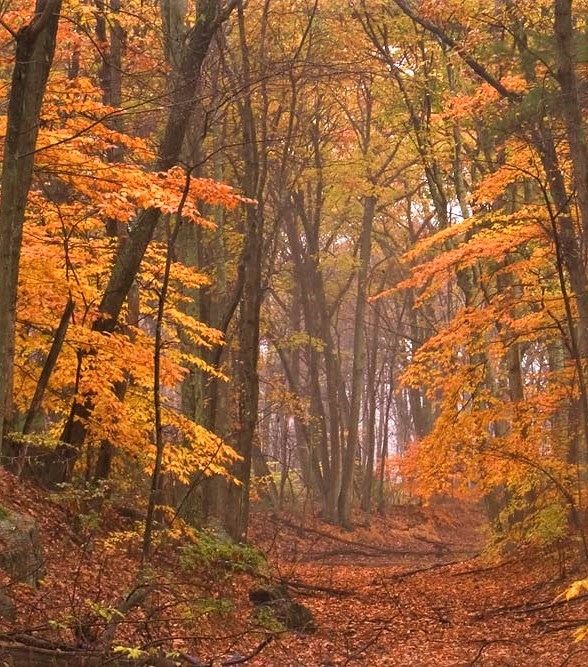
Twenty years ago, after a long search for the perfect haven, my husband and I purchased part of an old farm in southern Stokes County. The land was long gone to forest, and our tract a wedge-shaped portion including a high sandstone bluff overlooking a broad stream encircling loamy bottomland where the indigenous Saura people once camped and traded. Much of the bluff was cloaked in a mixture of evergreen hemlocks, red oaks and, to my great delight, beeches.
For the first two years, my husband and I spent all our free time exploring the property. Several evenings a week we’d drive up from town, often bringing sausages to grill on sticks over the small firepit we’d made on the top of the bluff. We listened to the wind, the owls, the Chuck-Wills-Widows calling mournfully in the wet bottomland near the stream. We courted the Landvaettir, the spirit of the property, leaving offerings, inviting the land and its various biomes and residents to reveal themselves. As we explored the land we found where wagon ruts carved the face of the bluff and rusting remnants of the barbed wire that had enclosed cattle wound from tree to tree around the hillside. The silty bottomland still bore the undulations of the farmer’s plough. A chevron of stones across the stream marked where the Saura had once maintained a fish weir. People long prior to us had left their mark on this land – how would we engage with it?
Close by the small clearing that surrounded our little fire pit were a pair of beech trees, perhaps thirty years old. I have loved beeches since my childhood for their smooth, silvery bark and finely serrated leaves that turn tan in autumn, clinging throughout the winter to warm the dreary landscape. As a child, I was convinced that they were the magical Mallorn trees that J. R. R. Tolkien described in his books, “The Hobbit” and “The Lord of the Rings”. Water-seeking, beeches often thrive next to springs and can grow to great size, with broadly spreading, undulating branches forming a rounded canopy.
During our frequent visits to our land, we were observant, noting where Sunna and Mani rose and set through the course of the seasons and how the weather patterns moved. As I worked on a plan for the small passive-solar cottage we hoped to build, I asked the land to show me how best to situate the structure. Toward our eastern boundary, high on the bluff above the stream, a spot revealed itself: the location of our firepit. How fitting for a pair of metalsmiths! The beeches that stood to the south-east and west would offer cooling shade in the summer. Their winter leaves could act as a windbreak and offer color in an otherwise drab season. I came to view them as dear friends and when, in time, we began the construction of our little cottage, I made sure to erect conspicuous fencing to insure our beeches would be safe from clumsy workmen.
The beech to the southeast of the cottage now anchors a natural area outlined with chunks of the white quartz so common here, filled with bluebells and daffodils, ferns and hellebore. Its pale gray, mottled trunk is now almost two feet in diameter at the base. In summer, the long undulating branches cast deep shade that shelters our cottage from the sun’s heat.
To the west, another beech embraces our elevated deck and bedroom, blessing us with the sense that we are living in a treehouse. All through the winter, her silvery, twining boughs are dressed in glossy tan leaves that sizzle in snow and sleet and rattle and whisper in the wind. The setting sun sets them alight and they glow a rich gold. As the land gradually warms in spring, Grandmother Beech awakens from her winter slumber and sweet sap begins to rise within her. Then, on a warm and windy day in late spring, a day chosen by some arcane biological magic, she lets go her tawny cloak and the leaves that have adorned her throughout the winter whirl free, borne by the wind to add their nutrients to the forest duff.
Over the following week, her leaf buds swell within shiny tan husks until their growing bulk splits the casings and tender, lime-green spirals of new foliage unwind and spread. Within four or five days, the bare twigs are laden with fresh new leaves. Among the gnarled gray roots, mossy earth below is once again shaded and cool. I watch this process from my bedroom window: tan wintery leaves setting sail, swelling new growth, and finally, rich green foliage casting sweet dappled shade across my bed.
Grandmother Beech, I thank you for the gift of beauty in all seasons. You teach me that Nature is not static and that all things change, even as I now watch your swelling buds and await the unfurling of your fresh chartreuse gown. Where ice has broken limbs, you’ve adapted and put out lateral branches. Where a surveyor long ago marked a boundary with a metal stake, your strong, white wood is gradually teaching me that boundaries are manmade and transient. You honor your own inner wisdom, not bound to any human calendar. Both guardian and teacher, I hail you!